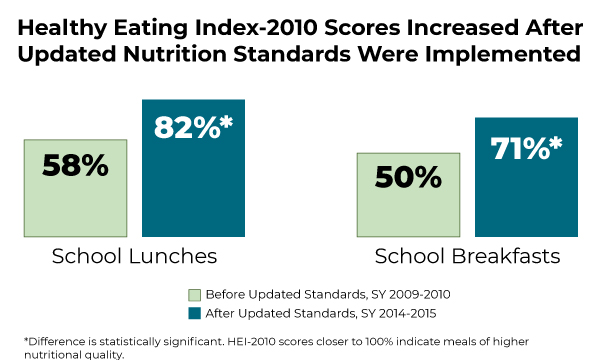The first comprehensive national study of the school meal programs following major reforms prompted by the Healthy, Hunger-Free Kids Act of 2010 found that school meals are healthier than they were before the reforms and that students are eating the healthier meals. The School Nutrition and Meal Cost Study, funded by the U.S. Department of Agriculture (USDA), Food and Nutrition Service, examined the nutritional quality of school meals in school year (SY) 2014–2015, two years after schools began using updated nutrition standards that called for more fruits, vegetables, and whole grains and for limits on calories, saturated fat, and sodium.
Using the Healthy Eating Index-2010 (HEI-2010), a team of researchers from Mathematica measured the nutritional quality of school meals in SY 2014–2015 and compared them with meals in SY 2009–2010. Findings showed that total HEI-2010 scores for school lunches increased from 58 percent of the possible maximum score to 82 percent, and total scores for breakfasts increased from 50 percent of the possible maximum to 71 percent (see figure below). The study also found that student participation in the school lunch program was higher in schools that served lunches with the highest nutritional quality and lower in schools that served lunches with the lowest nutritional quality.

The study also found the following:
- School food authorities (SFAs) faced challenges in implementing or maintaining compliance with the updated standards. The greatest challenge SFAs faced was the cost of foods that need to be included in meals in order to meet the standards. More moderate challenges included the availability of appropriate foods; staff training; the need for additional staff labor; and the need to offer different portion sizes to different grade groups.
- On an average school day, more than half of students in U.S. public schools participated in the school lunch program. Participation was highest among elementary school students (71 percent) and substantially higher for students who received meals free or at a reduced price compared with students who did not receive meal benefits (78 percent versus 35 percent).
- Students who ate a school lunch were more likely to consume milk, fruit, and vegetables at lunch than students who ate lunches from home or other places. In addition, students who ate a school lunch were less likely to consume desserts, snack items, and beverages other than milk or 100 percent fruit juice.
- Students didn’t always eat all of the foods in their school lunches. Waste was highest for vegetables, milk, and fruit and lowest for entrees and meats/meat alternates. These data are consistent with findings from studies conducted before schools implemented the updated nutrition standards.
- The cost of producing a school lunch in SY 2014–2015 was significantly higher than it was in SY 2005–2006 when USDA last studied this issue. Program operators work to balance the costs and revenues of the programs to operate on a break-even basis. In SY 2014–2015, however, the average SFA operated at a small deficit.
“What’s most compelling here is that the updated nutrition standards achieved their objective of making the meals healthier, and that student participation rates were higher in schools with the most nutritious lunches compared with schools with the least nutritious lunches” said Mary Kay Fox, nutrition policy expert and Mathematica project director. “This is important because many people worried that students would not participate in the school lunch program after the updated nutrition standards took effect.”
The National School Lunch Program and School Breakfast Program ensure that school-age children have access to nutritious meals and snacks to support their growth and development. Starting in SY 2012–2013, schools began using updated nutrition standards that affected the food and nutrient content of school meals and the types of foods students need to include in their meals. USDA contracted with Mathematica to conduct the School Nutrition and Meal Cost Study to examine the updated standards’ implementation and potential impacts on program operations, nutritional quality of meals, plate waste, students’ dietary intakes, and costs. Since the 1990s, Mathematica’s rigorous studies of the school meal programs have produced crucial evidence policymakers have used to make decisions about reforms to these programs and other policies that impact young people and families across the country.

